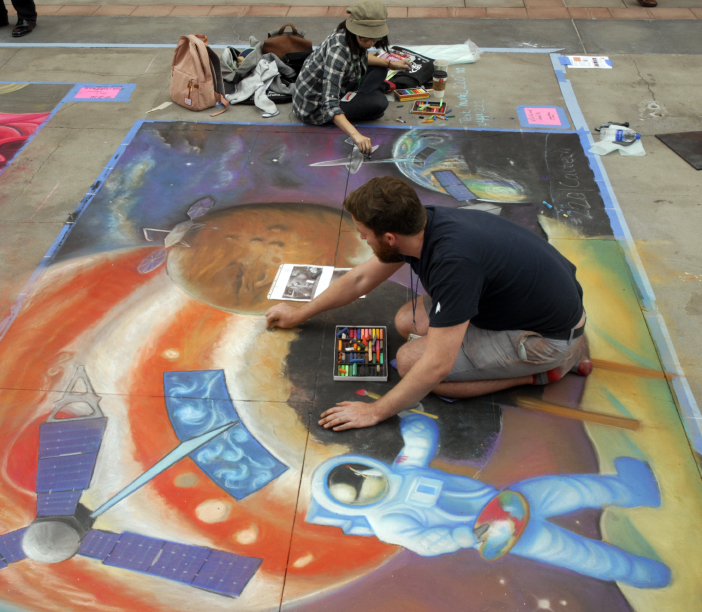Chalk One Up for Science
A team of artists represented campus and JPL at the Pasadena Chalk Festival, held in June at the city’s Paseo Colorado (see story at right). Their artwork, entitled Out-of-This-World, featured past, present, and future space missions including Juno, OCO-2, and Mars InSight. The paintbrush-wielding astronaut (above) is drawn in the style of Alan Bean, the late astronaut who was also an artist. Photo/Thomas Willard
“I loved the idea of an art-and-science collaboration. My two worlds coming together!”
That was Sarah Flores’s enthusiastic response to an invitation from the Pasadena Chalk Festival this past spring to work on a chalk mural with colleagues from the Caltech campus and from JPL, where Flores is a software engineer.
Irena Li and James Keane spent hours crouched on the concrete at the Paseo Colorado bringing life to their chalky solar system. Photo/Thomas Willard
Flores—who, in addition to her scientific day job, has been a street painter for 15 years and took art classes in high school and college—is no stranger to the annual June chalk fest, having participated in it since 2010. But the idea for an art-and-science collaboration came from Tom Coston, president of the Light Bringer Project, the nonprofit art organization that runs the festival.
With the chalk mural, titled Out-of-This-World, Flores says she and Coston hoped to convey the idea that art and science are “both important, and it’s exciting when they collaborate.” Art, she adds, “can inspire the next generation to dream about what can be possible.”
Putting together a team of artist-scientists was easy, Flores says. “Engineering and science, by nature, require a lot of creativity and problem solving. I’m not surprised that so many JPLers are also artists.”
Irena Li, a mission operations systems engineer at the Lab who has a background in chalk art, signed up first, and introduced Flores to Caltech planetary science postdoc James Keane, who regularly turns his hand to science illustration. Keane’s partner Aaron Rodriquez, a graphic designer, came on board as well, and the team was completed with Jamie Molaro, a JPL planetary scientist who advised on the design of the mural, and Eugenie Song, a JPL Mars operations engineer with arts training.
Starting out with a simple solar-system concept during the design phase, the group decided ultimately to showcase missions past, present, and future, including Juno, the Orbiting Carbon Observatory-2 (OCO-2), and Mars InSight. A late addition was the astronaut wielding a paintbrush, drawn in the style of Alan Bean—an Apollo 12 astronaut and the fourth person to walk on the moon—who passed away in May of this year. After retiring, Bean had pursued an interest in painting and become a fulltime artist.
As they set to work at the Paseo Colorado site, each member of the team focused on different elements. As they progressed in filling in the mural, says Li, “we referenced each other’s work or asked to trade areas so it ended up being a blend of all our individual artistic styles. I had a lot of fun learning new chalk techniques from the rest of the team.”
For Keane, working in chalk posed some unique challenges. “I usually use pen and pencil for my artwork, on nice, smooth paper,” he says. “Sidewalk chalk is a lot messier and more physically demanding. You’re on your knees for hours at a time, blending and breaking chalk into the rough concrete. I needed to ice my knees after each day of work. Also, the sheer size of the piece was daunting compared to my usual pen-and-paper sketches.”
The effort was worth it, though, he says. As festival visitors strolled by, they stopped to ask questions about the planets and missions in the mural. “I hope they left with a sense of excitement for the work going on at Caltech and JPL, and for how beautiful the solar system is.”
On a more practical note, says Keane, “the crowd was pretty good about not stepping on the artwork— except for the occasional rogue toddler or curious puppy.”


